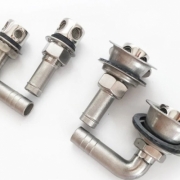Things You Should Know About Boat Tank Elbow Ventilation
Understanding boat tank elbow ventilation is crucial for maintaining the safety and efficiency of your boat’s fuel system. Boat tank elbow vents are specifically designed to fit in areas with limited space where a full body pump might not be feasible. Most boats are equipped with a full body pump, and the boat tank elbow vent is usually located at the rear of the boat. It is connected to the main pump to facilitate the venting of the tank.

The design of boat tank elbow vents allows them to be effective in various conditions, including during bad weather or long trips. It’s important to note that these vents are integral to the boat’s fuel system, as they allow air to vent from the tank as it is filled with fuel. This process is essential for preventing pressure build-up within the tank.
In addition to the main port, most boats also have a secondary port that can be used for venting the tanks, especially if the main port becomes blocked. This secondary port is typically located further forward than the main port. Both ports can be used for venting, but the ease of venting often depends on their exposure to wind and other environmental factors.
Furthermore, the location of the vent at the stern of the boat, where steering typically occurs, is strategic. This positioning ensures that the vent is less exposed to wind compared to the main port, granting more control over the boat’s direction during challenging weather conditions or when taking on water.
Marine fuel tank vents are a critical component of a boat’s fuel system. They serve not only to prevent pressure build-up but also as a safety feature against potential explosions caused by fume accumulation, particularly in boats powered by gasoline. Since 1940, it has been a legal requirement for gasoline-powered boats to have a ventilation system, which can be either natural or powered. The choice between natural and powered ventilation systems depends on the boat’s specific design and operational conditions.
In the context of maintenance and safety, it’s important to regularly check and maintain these ventilation systems. Proper ventilation is key to ensuring a safe and enjoyable boating experience, and boat owners should be aware of the different types of ventilation systems and their requirements.
Improving ventilation in boats is a relatively affordable upgrade that can significantly enhance comfort and safety onboard. Options like ports, hatches, cowl vents, and patent ventilators can be used to either extract air or bring fresh air into the boat, depending on the boat’s design and usage. The effectiveness of the ventilation system varies depending on whether the boat is stationary or underway, highlighting the importance of a well-thought-out ventilation strategy.
In conclusion, understanding and maintaining boat tank elbow ventilation is essential for the safe and efficient operation of your boat. Regular checks and maintenance of the ventilation system, along with an awareness of the different types of systems available, will ensure a safer and more comfortable boating experience.





